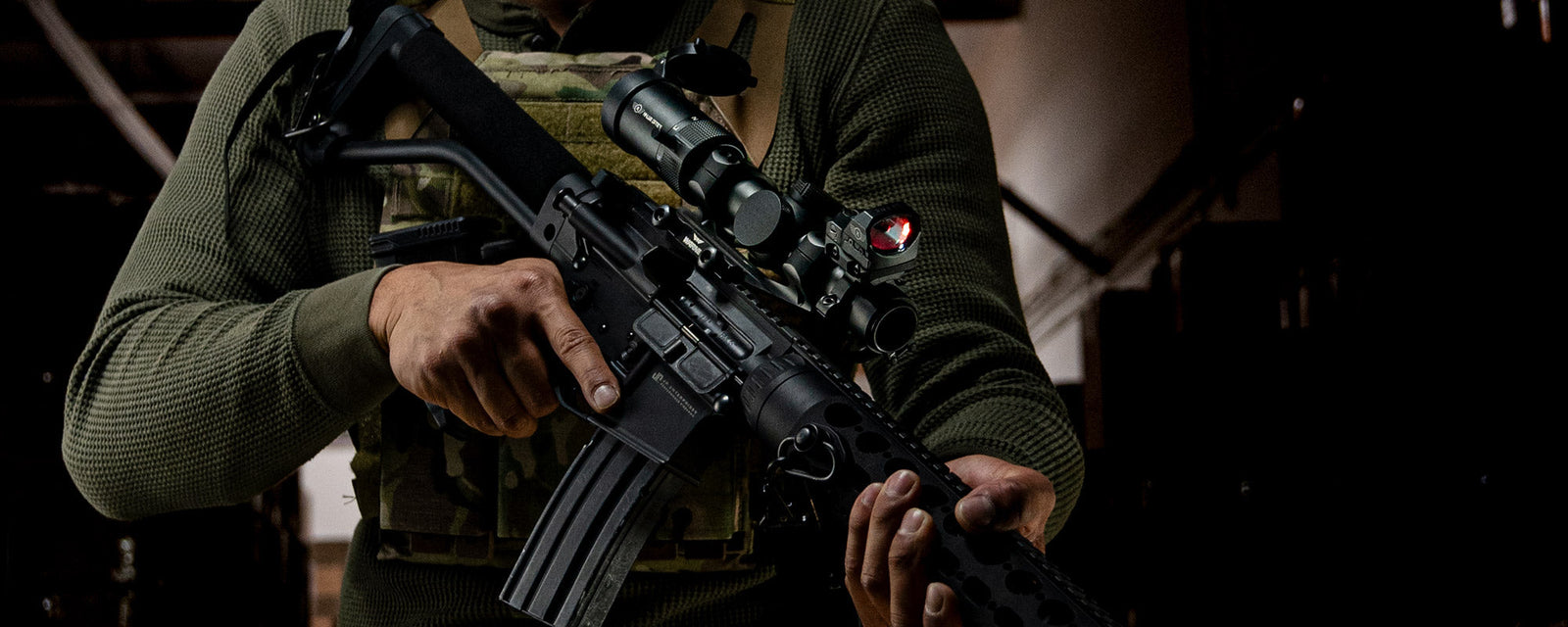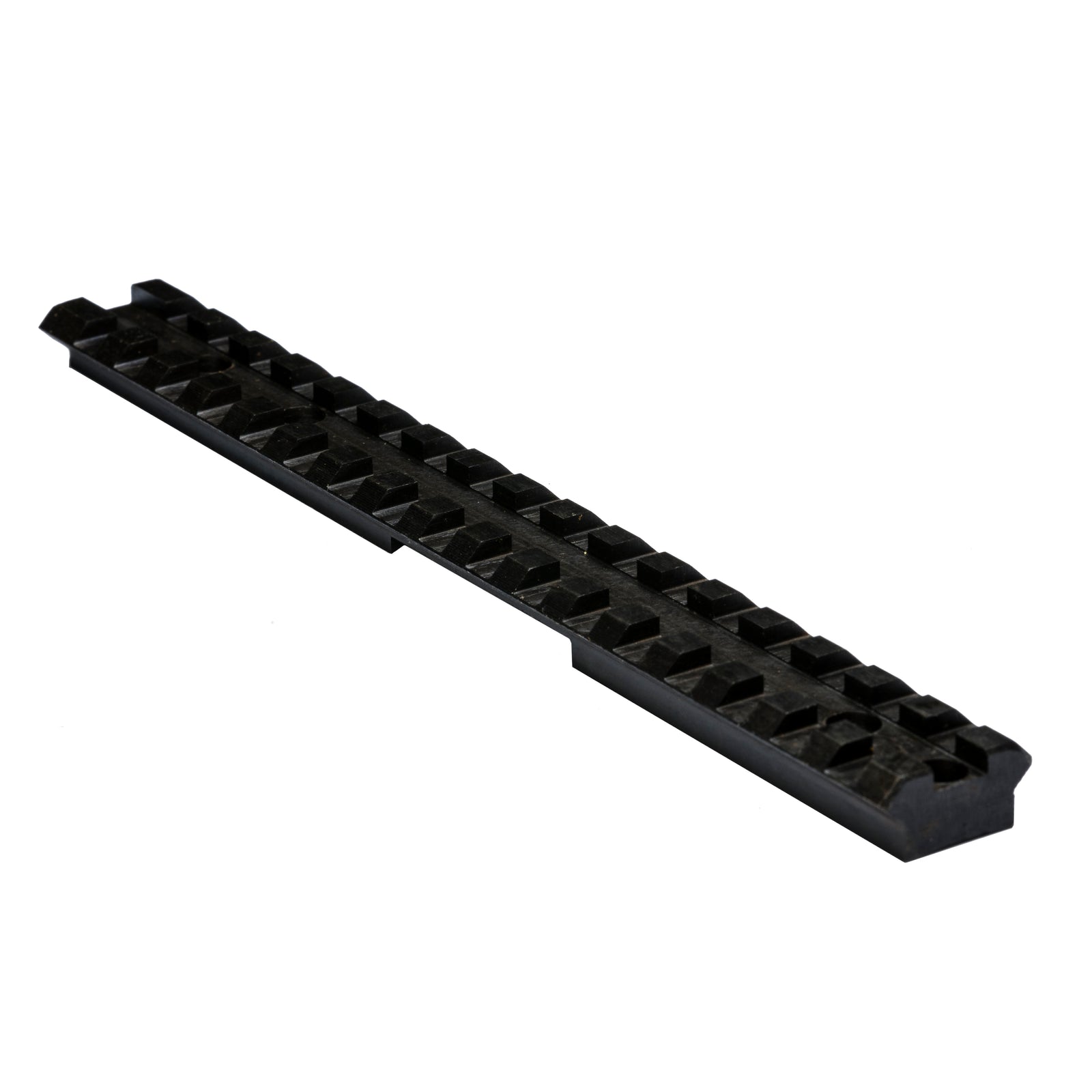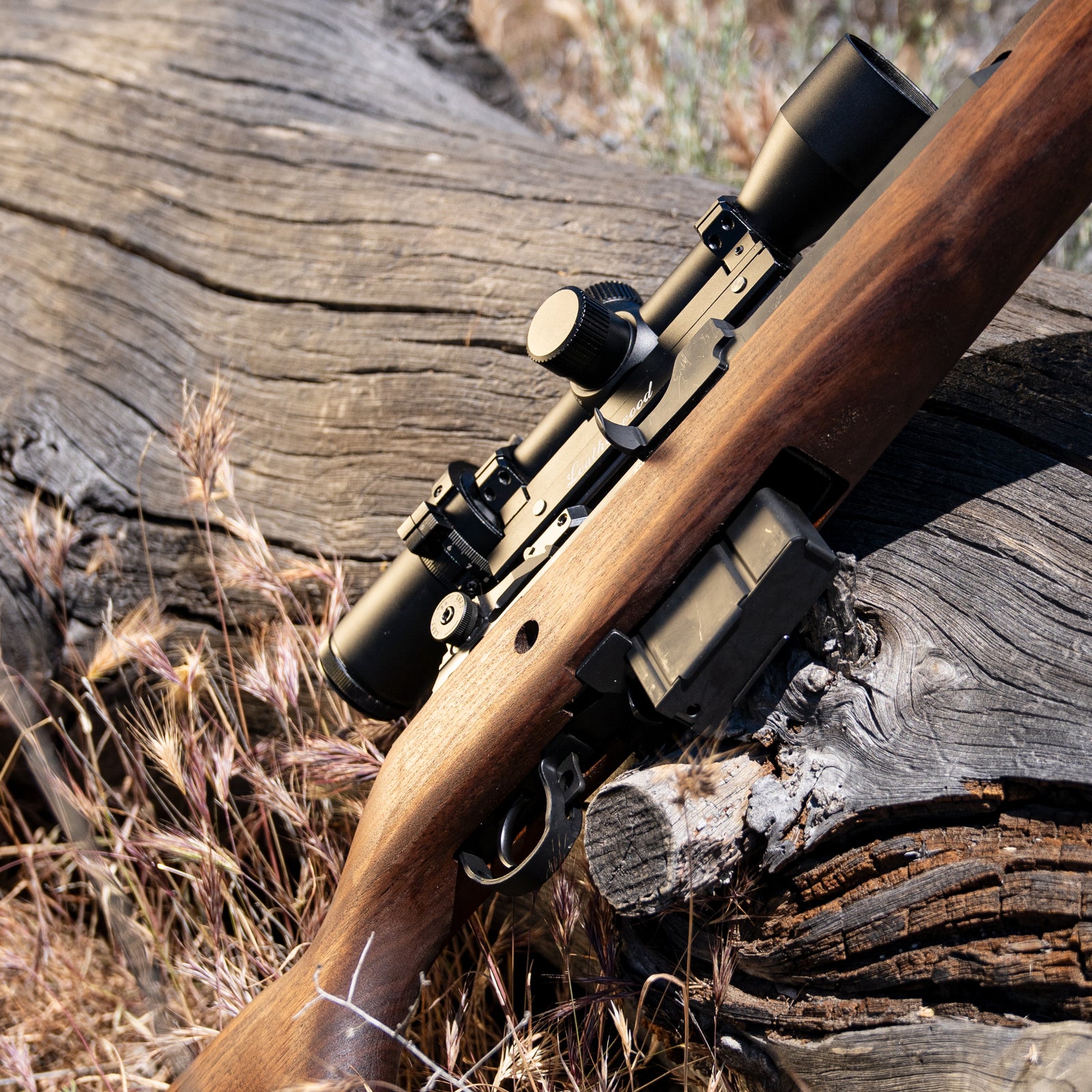AR. Two letters that have been unusually popular, and only more so over time. I’m not talking about Alternate Reality. I’m talking about the rifle(s) that go by that moniker. I’ve seen AR stand for many things online - America’s rifle, assault rifle, and even automatic rifle. None of these are the proper meaning of the acronym. We’ll get right into why.
We’ll just have to take a little walk through history to get there.
Before the AR-15
The story behind the AR-15 really lies in the battle between the AR15 (M16) and M14. That particular series of events will show up later, after a look through the development of the AR-15's earliest iterations.
The name most associated with the AR-15 is Eugene Stoner. Born in 1922 in Indiana, Eugene eventually moved to Long Beach, California with his family. He attended Long Beach Polytechnical High School, and eventually went on to work at Vega Aircraft Company. Vega, as a side note, would eventually go on to become Lockheed Airplane Company, and then Lockheed Martin. During WWII he enlisted with the Marines and worked in Aviation Ordnance, where he finally had the chance to experience full-power automatic weapons.
On his return home, he joined Whittaker and eventually became a design engineer. A decade later, in 1954, Eugene joined ArmaLite. We have finally arrived at the A in AR; ArmaLite. Curiously, ArmaLite was founded by the patent counsel for Lockheed, George Sullivan. Small world. And, contrary to many assumptions about the Los Angeles area, the rifle was developed in Hollywood, California.

Working at ArmaLite, Eugene developed a number of ArmaLite Rifle models. That's the whole set of words behind AR: ArmaLite Rifle. The AR-3 had been a model he initially developed individually in the 40s, featuring a gas-operated self-loading system and chambered for the 7.62x51mm round. It came to incorporate an important property that ArmaLite used in their firearm design - lightweight materials. The receiver was made of aluminum, while the stock was made of fiberglass. As natural as these materials sound to the modern ear, they were rather unusual in an era of steel and wood.
Also in 1954, Eugene developed the bolt action AR-5 Survival Rifle. It was a rare success for his firearm designs, eventually adopted by the US Air Force from 1956-1959. It was given the designation MA-1, and everything seemed ready to go for a large scale rollout. However, a related Air Force program was canceled (the XB-70), and funding was never allocated for purchasing beyond the initial 12 test models of the AR-5. Despite the lackluster purchase, it still established ArmaLite as a company that was accepted by a branch of the military.

Eventually we arrive at the AR-10. The initial design work for the AR-10 was completed in 1955. In 1956, a patent was finally awarded for the Stoner bolt and carrier piston system. In the words of the patent, “This invention is a true expanding gas system instead of the conventional impinging gas system.” The AR-10 included a few other notable design choices:
- The stock was in-line with the barrel, allowing recoil to push straight back. Older rifles had the barrel sitting much higher than the contact point on the shoulder.
- The AR-10 was lighter than other infantry rifles by a pound or more.
- The upper and lower halves of the receiver were separable through a system quite like the modern pin design of the AR-15.
- In addition, the AR-10 was chambered in 7.62x51mm.
We should take a moment to look at the 7.62x51mm cartridge. While it has a history all its own, the 7.62mm bullet has a particular importance to the upcoming story. Testing by the Army's Caliber Board at Aberdeen in 1928 resulted in a recommendation to move to smaller caliber bullets (in particular, a .27 cal). In favor of tradition, the Army ignored this recommendation. Command decided to stick with .30 cal for the next few decades, considering it 'full-sized'. Still, the concept of a small-caliber and high velocity round had been presented. In contrast to a full-sized cartridge, these lighter rounds were considered intermediate.
Not long after the 1956 patent, the AR-10 would also be tested at Aberdeen alongside a few rifles to replace the classic M1 Garand. It was not selected at the time; that honor went to the T44, eventually designated the M14. The M14 was not without issue, having both too small a magazine and too little control to function well for automatic fire. It faced further difficulty against the AK-47 in the early days of the Vietnam War.
The issues with the M14 brought a request from General Willard G. Wyman in 1957. He had desired a 6 pound rifle (when loaded with a 20 round magazine), chambered in .223 (5.56mm), that could penetrate a standard helmet at 500 yards, and retain supersonic velocity at such distance. It would also be nice if that same rifle was more capable at accurate automatic fire. His requests echoed, in large part, the recommendations from the 1928 testing.
The AR-10 Becomes the AR-15
It is in the story of the M14 and M16 (AR-15) that we find a serious cluster of misinformation, conflicting reports, subterfuge, and personal interest. I’ll try to keep everything tidy, though this is by no means a straightforward series of events.
In 1957, the AR-10 was resized to fit the .223 Remington cartridge and given a new designation: AR-15.
Eugene Stoner first unveiled the AR-15 for the military at Fort Benning in May, 1957. Initial assessments were positive. The .22 caliber rounds were lighter than the .30 caliber then in use. Troops could carry more rounds at the same loadout weight. The lighter recoil impulse also allowed for better control under automatic fire. Many parts could be made through stamping, reducing the effort and cost of production. The rifle itself was also made of lighter materials than most others, including a plastic stock. By all accounts, this rifle seemed to fulfill General Wyman’s request.
In 1958, the Army's Combat Developments Experimentation Command ran their own tests of the M14, AR-15, and another Winchester rifle. 10 AR-15 rifles and 100 of the 25-round magazines were sent to CONARC (Continental Army Command), where General Wyman was in charge.
The testing staff concluded that a lightweight rifle was a great idea, and specifically that the rifle should be similar to the AR-15. It was found that a five to seven man team with AR-15s had similar firepower to an 11 man team with M14s, and could carry three times the ammo. General Maxwell Taylor, then Army Chief of Staff, responded by declaring that all rifles and machine guns should use the same ammo (.30 cal). They doubled down on the M14, despite the issues it presented at the time. The AR-15 was abandoned, despite how reliable it was in testing and how perfectly it fit Wyman's request.
ArmaLite had sunk a great deal of money into this and prior AR models. Even so, they were not getting any positive results. In 1959, the AR-10 and AR-15 designs were sold to Colt due to financial and production limitations at ArmaLite.
The initial 1957 design of the AR-15 was short-lived. Colt made a few minor changes upon acquisition, though most notably moved the charging handle from under the carry handle to the rear of the receiver. The rifle was also rebranded as the Colt 601 or the Colt ArmaLite AR-15 Model 01, but had to leave ArmaLite markings on the rifles due to contractual agreements.
This configuration - the Stoner gas impingement system, the position of the charging handle, an in-line stock, lightweight parts, chambered in .223 Rem - became the iteration of the AR-15 that was later adopted as the M16. However, I've gotten ahead of myself. There are many steps between the 1959 makeover and the later M16 adoption.
A Battle of Calibers
Colt used its resources and production knowledge to work further on the AR-15 project. The rifle was redesigned for mass production, including more stamped parts. The team went on a demonstration tour to the far east, and landed a sale to Malaya in September of 1959. The first 300 production models of the AR-15 were pumped out in December of 1959.
Air Force Vice Chief of Staff General Curtis LeMay also ran tests with the AR-15 in 1960. He was suitably impressed, and ultimately concluded that it should become their standard issue rifle. He ordered 8500 rifles and 8.5 million rounds of ammunition.
The U.S. Army conducted further marksmanship comparison testing between the AR-15 and M14 in 1961. They found that 43% of AR-15 shooters could rank as Expert, while only 22% of M14 users could. These tests also underscored the difference in control when using select fire (the AR-15 was ranked as far more controllable).
In the summer of 1961, General Curtis LeMay was promoted from Vice Chief of Staff to Chief of Staff for the Air Force. He requested a further 80,000 AR-15s. His request was blocked by President Kennedy on the advice of General Maxwell D. Taylor, Chairman of the Joint Chiefs of Staff. General Taylor had made the argument that having two cartridges in general rotation would be detrimental. And that, in a debate between a .30 and a .22, the choice was obvious.
In October of 1961, Advanced Research Projects Agency (ARPA) sent 10 AR-15s to the Army of the Republic of Vietnam (ARVN). Initial results were positive, and a further 1000 rifles were sent in 1962. South Vietnamese troops tested the rifles extensively. To summarize their results: they required only two replacement parts across the whole 1000 test rifles during the entire course of the tests. The reports concluded that the AR-15 should be sent to South Vietnam for use by their troops, immediately and in quantity.
This request by the ARVN was rejected by Admiral Harry Felt, then Commander in Chief of Pacific Forces, on the word of the Army.
The AR-15’s story does not end here, but it did take a short break.
1962 and Onward
In 1962 and 1963, further tests were conducted by various divisions of the military. The rifle was praised for its lightness, reliability, and lethality. The Army Materiel Command criticized it for its stopping power and accuracy at greater distances.

This criticism by the Army did not deter other interested parties. In 1963, US Special Forces requested and were granted the AR-15 as their standard issue weapon. Army Airborne units stationed in Vietnam followed suit. Units operating alongside or for the CIA did the same.
This ever increasing list of supporters caught the ear of Secretary of the Army Cyrus Vance, who started an investigation into why the Army had not adopted the AR-15. He ordered further tests of the M14, AR-15, and even the AK-47. He even ordered testing of the investigation methods themselves, and investigations of earlier Army tests.
Ultimately, the investigation found that the Army Materiel Command had rigged tests. The M14s used in the tests were put in situations that favored the M14, and furthermore were Match Grade M14s. The AR-15s were simply out of the box models.
Arguments arose and sides were chosen. The Air Force and the civilian leadership at the Department of Defense were on the side of the AR-15. The Army Ordnance agencies were against.
Secretary of Defense Robert McNamara finally put a halt to the arguments in 1963, declaring the adoption of the AR-15 and the end of production for the M14. The AR-15 was the only rifle on the slate that had potential as a universal service weapon with the potential for sufficient production. Late in 1963, he selected the Army as the procurer of the rifle for the DoD.
This is where the story should have ended. Should have, but didn’t.
Adopting the M16
Before the AR-15 (then M16) was fully adopted, one small change was still yet to come. The Army, as the procurer of the rifle, had certain permissions to change aspects of the rifle. They requested a manual bolt closing device (also known as a forward assist), which could be used to ram a round into place if the round had failed to feed or seat properly. The Air Force and Marines, who had both tested the rifle, objected to the addition. The Air Force in particular stated, “During three years of testing and operation of the AR-15 rifle under all types of conditions the Air Force has no record of malfunctions that could have been corrected by a manual bolt closing device.” The bolt closure device added complexity and reduced the reliability of the weapon for reasons that seemed entirely superfluous.

The forward assist became a long-standing point of contention. The Army's model of the M16 (XM16E1, later the M16A1) included a forward assist. The Air Force's model (base M16) did not have a forward assist.
Colonel Harold Yount, who was then in charge of procurement for the Army, later went on to explain that the addition was made at the direction of senior leadership. It had not been added due to any testing or failures during testing. He added detail in stating, “the M1, the M-14, and the carbine had always had something for the soldier to push on; that maybe this would be a comforting feeling to him or something.”
At last, the story of the AR-15’s military development seemed to conclude. A few more changes occurred later, but they are of a relatively minor concern. The AR-15 started production in 1964 under the designation Rifle, Caliber 5.56 mm, M16.





Jonathan
October 16, 2024
From my understanding Armalite started with the 222 Remington cartridge. I actually have a original unopened box of 222 Remington made and marked armalite used in the prototypes.